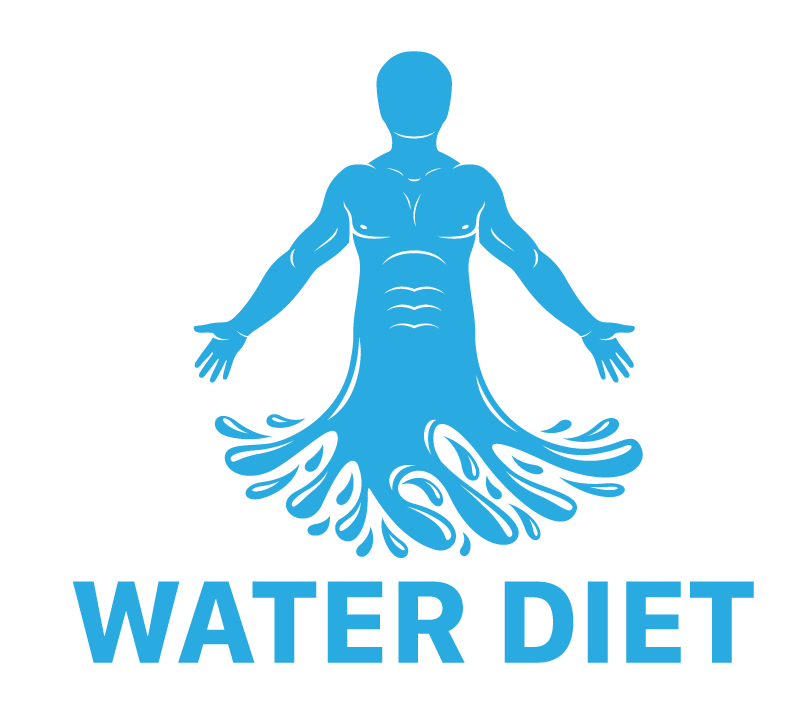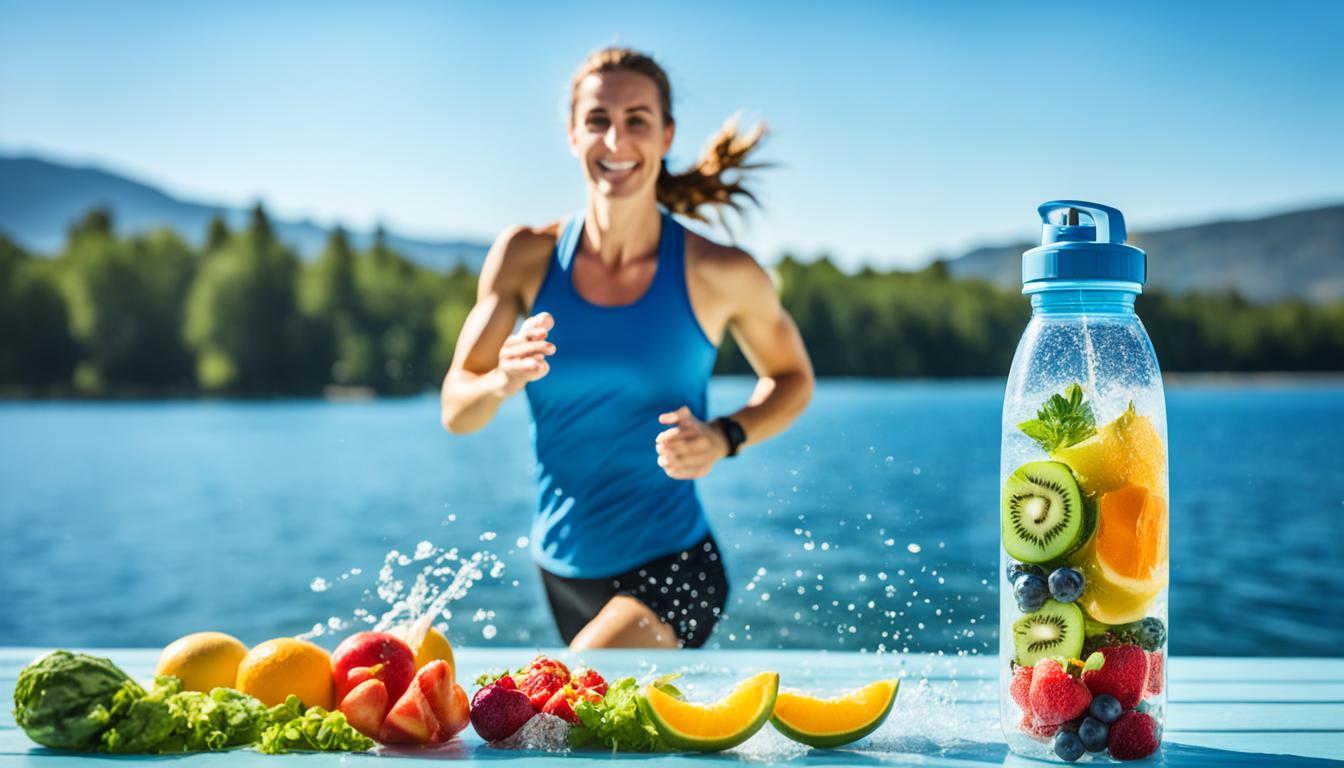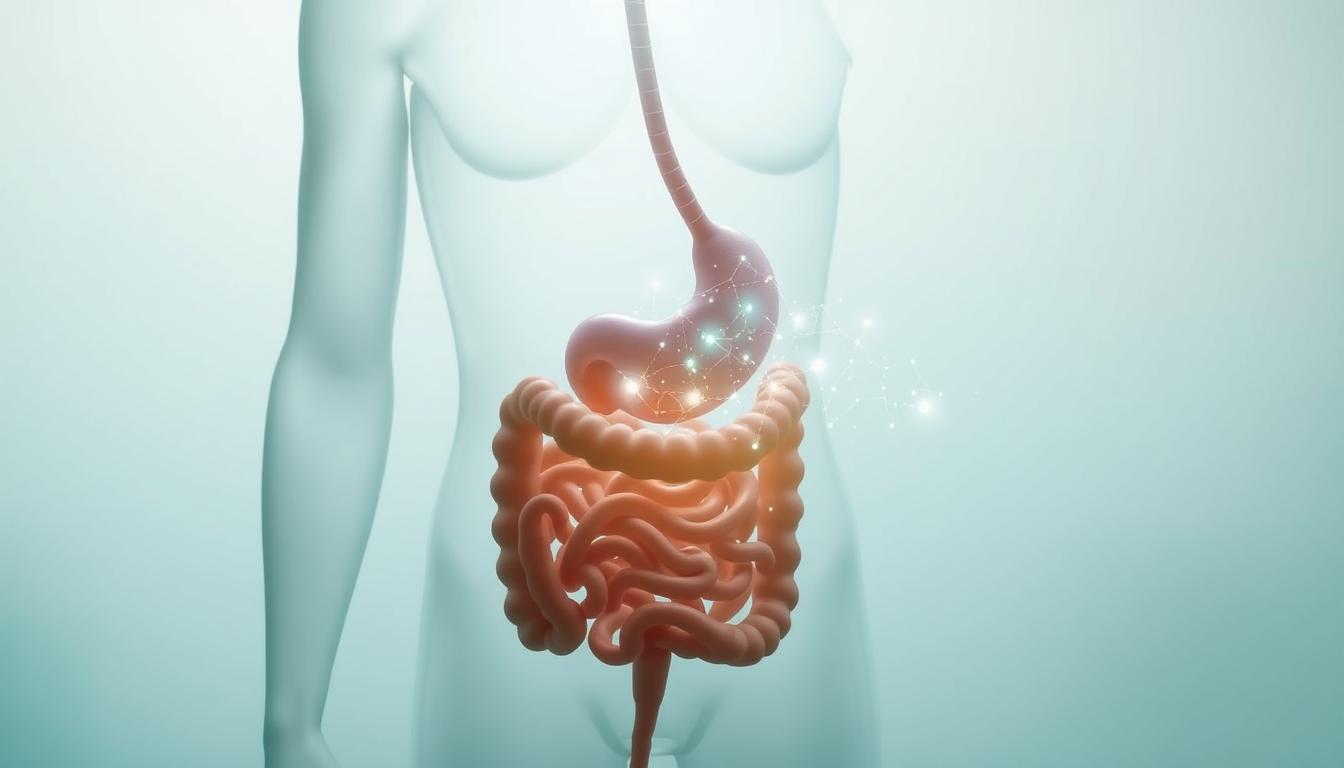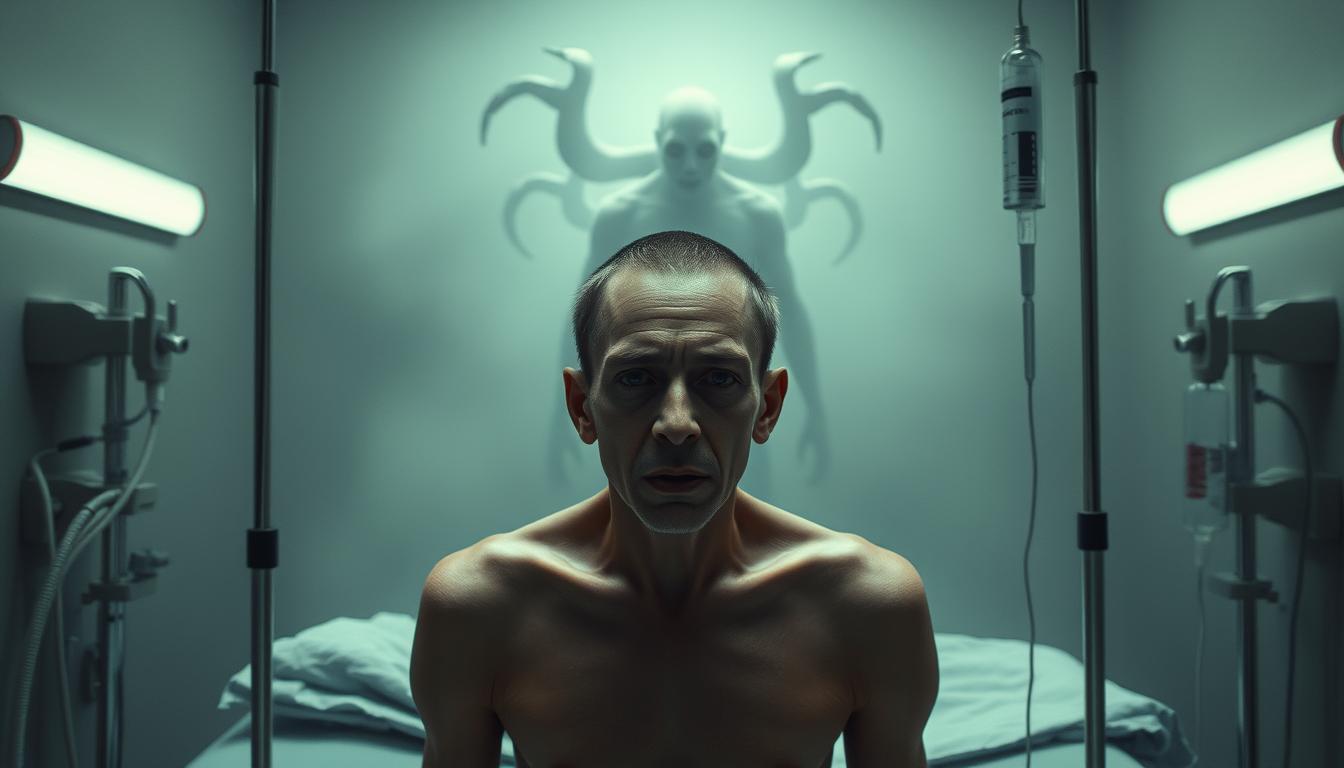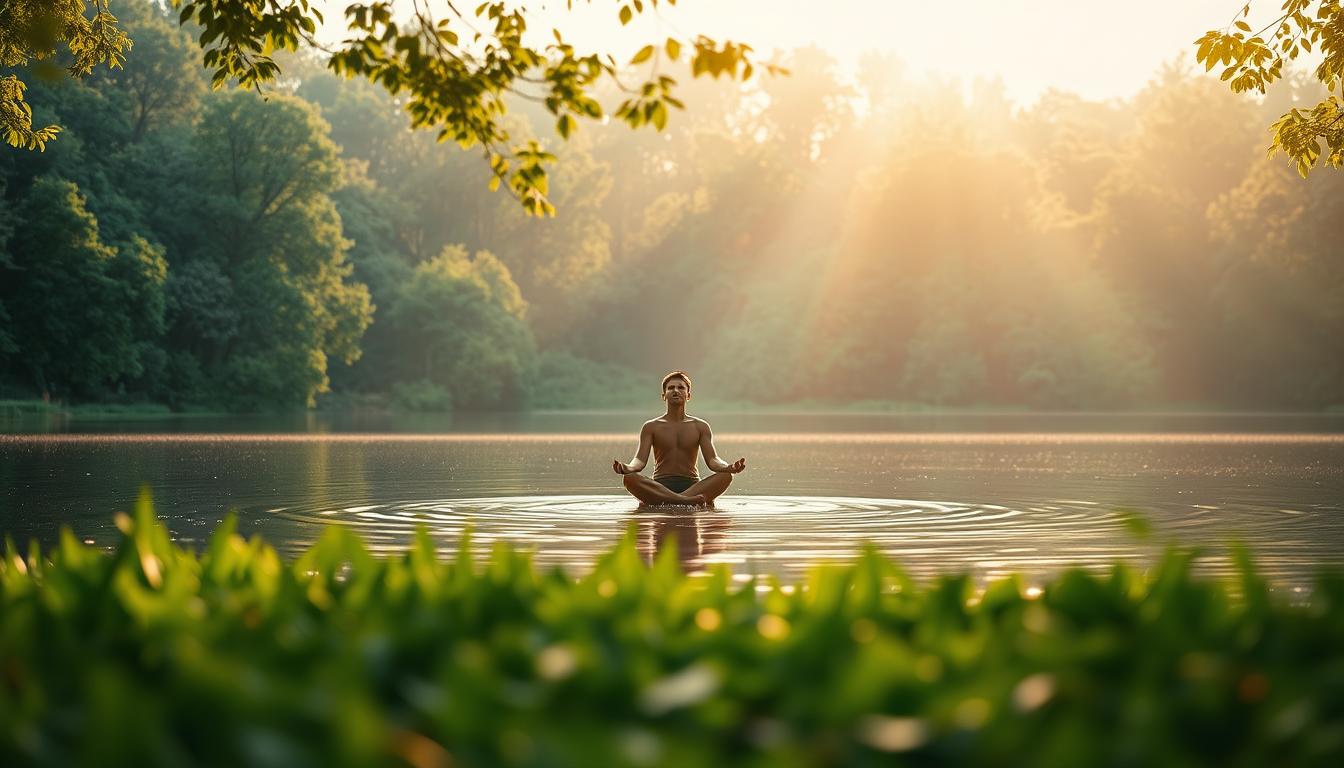Staying properly hydrated is key for optimal performance and safety while working out. Our bodies are mostly water, about 60%1. Dehydration can badly affect how well we can exercise, and the health risks are serious. These risks include issues such as heat problems, troubles with our urinary and kidney systems, seizures, and shock1. Signs that you’re getting dehydrated include feeling very thirsty, having a dry mouth, feeling tired, dizzy, or getting a headache, noticing dark-colored urine, and not needing to pee as often2.
To avoid dehydration and keep performing well, making a hydration plan that fits you is crucial. This plan should consider things like how big you are, how much you sweat, how hard you’re working out, and the weather2. Generally, it’s advised to drink 18–20 ounces of water a few hours before you start, another 8 ounces right before, 7–10 ounces every 10–20 minutes while exercising, and 16–24 ounces for each pound you lose after you’re done3.
But, water isn’t the only thing you need. Keeping your electrolytes in check is also very important for your body fluids, muscles, and health overall1. When we sweat, we lose key electrolytes like sodium, potassium, and magnesium. This happens a lot during intense or long exercises, with sodium losses hitting 500 to 1,500 milligrams per hour12. A balanced diet can often cover your electrolyte needs. But really heavy sweaters, or those on special diets, might need extra help3.
Why Hydration Matters During Exercise
Why is staying hydrated so important when you’re working out? Well, your body is mostly water, about 60%. This water is key for many things your body does, like keeping the right temperature, making energy, and helping your muscles work better1.
The Role of Water in Temperature Regulation
Water is your body’s tool for cooling down through sweat. If you don’t drink enough, your body can’t keep its cool. This raises the chance for heat sicknesses such as cramps, exhaustion, and heatstroke4. Just losing 2% of your body’s water through sweat can hurt how well you do in sports1.
Hydration and Energy Production
For your body to turn food into energy, it needs water. Without enough water, you can feel tired, not last long in activities, and not do as well in quick, power movements1. Keeping up your water intake means you keep your energy levels in top form, helping you excel during exercise.
Maintaining Muscle Function and Performance
Water is crucial for your muscles. Not drinking enough can cause your muscles to cramp, weaken, and give out sooner1. Being just a bit dehydrated can really take a toll on how well you do in sports. If you’re really dehydrated, you can feel confused, weak, or even faint and need help right away4.
| Benefits of Staying Hydrated | Consequences of Dehydration |
|---|---|
| Regulates body temperature | Impaired temperature regulation |
| Supports energy production | Decreased endurance and fatigue |
| Maintains muscle function | Muscle cramps and reduced strength |
| Optimizes athletic performance | Significantly impaired performance |
If you want to keep hydrated, here’s what experts suggest. Drink 17 to 20 ounces of water a few hours before you work out and 8 ounces about 20 to 30 minutes before starting4. While exercising, try to drink 16 to 32 ounces every half hour1. After working out, drink about 24 ounces for every pound you lost in sweat. This helps replace all the lost fluids14.
Signs and Symptoms of Dehydration
It’s vital to know the signs of dehydration to stay healthy during physical activity. Recognizing these clues early on makes it easier to keep your body in top shape.
Dry Mouth and Thirst
Feeling a dry mouth and thirsty? It might mean you need more water. The American Council on Exercise says before exercising, drink 17 to 20 ounces of water within 2 to 3 hours4. If you’re active outside, have between 16 to 20 ounces of fluids a bit earlier, about 1 to 2 hours ahead of time5.
Fatigue and Dizziness
Dehydration can lead to feeling tired and dizzy. It can also cause muscle cramps, dry mouth, and a quick heart rate4. To stay ahead, have 6 to 12 ounces of water every 10 to 15 minutes when you’re working out5.
Dark Yellow Urine
Notice your urine is dark yellow? That could mean you’re not drinking enough. Try having 8 ounces of water just before exercising. Then, during exercise, aim for 7 to 10 ounces every 10 to 20 minutes to keep your urine color looking good and stay hydrated4.
Muscle Cramps and Headaches
Muscle cramps and headaches might show you need more water. For every pound lost during exercise, athletes should drink 16 to 24 ounces4. After working out, having another 16 to 24 ounces of fluids can help prevent dehydration headaches5.
| Symptom | Description |
|---|---|
| Dry Mouth and Thirst | Early indicators of dehydration, signaling the body’s need for fluids |
| Fatigue and Dizziness | Can occur as dehydration progresses, affecting energy levels and balance |
| Dark Yellow Urine | A sign of dehydration, as well-hydrated individuals typically have pale yellow or clear urine |
| Muscle Cramps and Headaches | Can be symptoms of dehydration, as the body struggles to maintain proper fluid balance and electrolyte levels |
Keep an eye out for these dehydration signs to act fast and stay strong. Without enough water, heat problems like cramps or even heatstroke can happen4. Get help right away if you’re showing severe dehydration signs, heat issues, or if you feel like you have heatstroke4.
Pre-Workout Hydration Strategies
Staying hydrated before you exercise is key to doing your best and avoiding dehydration. Your body is mainly made up of water, about 60 percent1. Aim to drink 5-7 milliliters of water for each kilogram you weigh, about four hours ahead of your workout6. This means you should have 2-3 cups (473-710 milliliters) of water within the last 2-3 hours before you start6.
If you work out in the morning, it’s crucial to be well-hydrated from the day before. You might not have much time to drink water before you start if you exercise in the morning. Going just 2 percent below your normal water levels can reduce how well you perform over a long period of exercise1. And it can also affect how well you do in short, intense exercises1.
Adding some carbs and sodium to the food or snacks you eat before working out can help your body use the water better. On average, you should get 1,500 to 2,300 milligrams of sodium each day1. Think about what you eat and drink before you work out. It can make sure your body is ready for the exercise ahead.
But always remember, the perfect way to stay hydrated changes depending on you and your situation1.
Now, let’s look at some ways to hydrate before exercise:
- Drink 16-24 ounces of fluid 2 hours before a workout
- Have an extra 8-16 ounces just before you start
- Make sure to eat some carbs and get enough sodium with your last meal or snack
- Set up a plan that works for you, to drink and eat before exercising
When you’re dehydrated, you might feel dizzy and your heart might beat faster1. These tips on getting enough fluid before you exercise can help. They get your body ready for the workout and help you do as well as you can.
Staying Hydrated During Exercise
Maintaining hydration during exercise is key for doing your best and staying healthy. Drinking enough water helps your body stay cool, carry nutrients, and get rid of waste. 88% of trainers worldwide loved a hydration guide, giving it top marks7.
Sipping Frequently Throughout Your Workout
Stay hydrated by sipping water often when you exercise. Try to drink water every 15-20 minutes. Drinking 16 to 32 ounces of water for every 30 to 60 minutes of exercise is good1.
Your water needs might change based on how long and how hard you’re working out, as well as the weather and altitude1.
Choosing the Right Fluids: Water vs. Sports Drinks
For workouts under an hour, choose water. But if you’re exercising more or harder, sports drinks can be better. They have electrolytes and carbs to help you out7. Electrolyte tablets also balance your electrolytes while you drink7.
Keep in mind that the body should get 1,500 to 2,300 mg of salt each day. You might lose 500 to 1,500 mg of salt in sweat every hour1.
| Fluid | Benefits | When to Use |
|---|---|---|
| Water | Hydrates the body, no calories | Workouts less than 1 hour |
| Sports Drinks | Provides electrolytes and carbohydrates | Intense or prolonged exercise (>1 hour) |
Listening to Your Body’s Thirst Cues
It’s crucial to know the guidelines for drinking while you exercise. But it’s also really important to listen to your body when it tells you it’s thirsty7. Don’t wait until you’re super thirsty to drink. Being just 2% dehydrated can already hurt your performance in sports1.
Always keep hydrated by sipping water, choosing the right drinks, and paying attention to what your body needs. Doing this will keep you in top shape. It will also help you avoid dehydration and stay healthy during your workouts.
Post-Workout Rehydration: Replacing Lost Fluids and Electrolytes
After you work out hard, your body needs to recover. It’s vital to replace the fluids and electrolytes lost when you sweat. Since our bodies are mostly water, getting rehydrated is key after exercising1. If you don’t drink enough, you might get dehydrated. This could lower how well you perform in your next workout, with just a 2 percent drop in fluid levels1.
Calculating Your Fluid Needs Based on Sweat Loss
To figure out how much water you need after working out, calculate the sweat you lost. Weigh yourself before and after the exercise to see how much you sweated. Then, for every pound you lost, drink 24 ounces of water1. The ACSM says that drinking water within 30 minutes of your workout helps a lot6.
The Importance of Electrolyte Replenishment
It’s important to replace the electrolytes you lose when you sweat, like sodium and potassium. These minerals are key in keeping your muscles working well and maintaining proper fluid balance1. Eating and drinking items rich in electrolytes, such as sports drinks, can help. On average, you should get 1,500 to 2,300 milligrams of sodium a day1.
After you drink enough water, have a snack or meal. Make sure it has carbs and protein. This helps your body recover and fills up your energy reserves. With proper hydration, electrolytes, and nutrition, you get ready for the next exercise session.
Determining Your Daily Water Needs
Staying hydrated is key to being healthy, especially if you’re active. The amount of water you need varies. It depends on different things like your age and how much you weigh. Roughly 75% of people in the US don’t drink enough water8.
Adults need about 8 cups of water every day on average9. For women, that’s around 11 cups, and for men, it’s about 15 cups. This is according to the experts at the National Academies of Sciences, Engineering, and Medicine10.
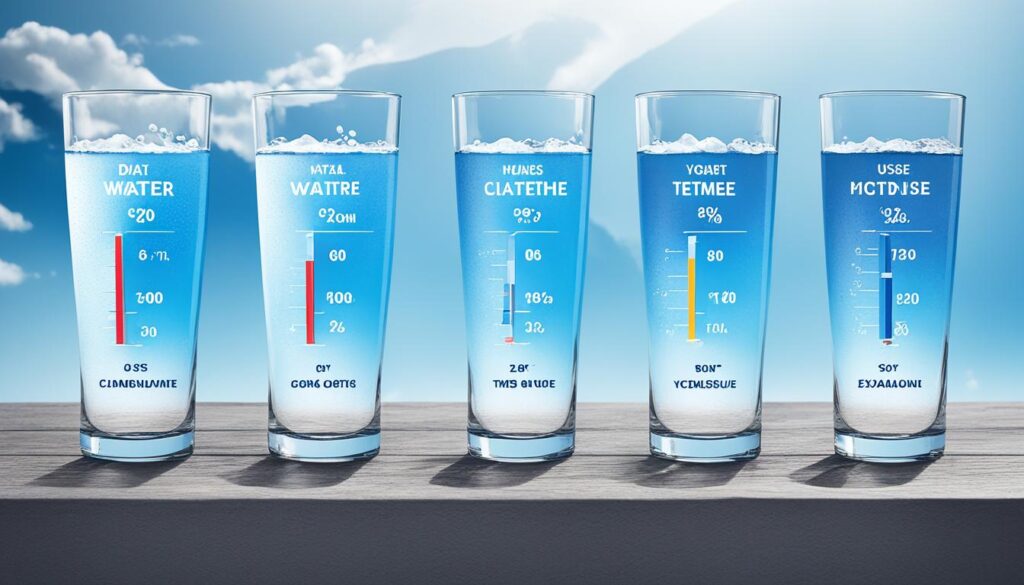
Factors Influencing Hydration Requirements
What you need to drink daily changes with your age, size, and how active you are. Older adults may not feel as thirsty but still need to drink plenty. If you’re bigger or doing intense workouts, you’ll need more water.
To figure out how much you should drink, divide your weight by two. For an example, a 150-pound person should aim for about 75 ounces of water a day9.
Using Urine Color as a Hydration Indicator
Your urine’s color can tell you if you’re hydrated enough. Dark urine means you should drink more water, while light yellow or clear urine is good.
By checking your urine color, you can make sure you’re getting enough water. Aim for a light yellow color to know you’re hydrated well9.
Remember, drinking water isn’t the only way to stay hydrated. Foods and other drinks count, too. If you’re working out or in hot weather, drink more water. For every 30 minutes of exercise, you should add 8 more ounces of water9.
Athletes have to be really careful. They might need to drink 4 to 8 ounces every 15 to 20 minutes of a workout. And they need to drink around 3 cups to replace every pound they lose in sweat10.
By paying attention to what your body needs, your urine color, and how much you’re moving, you can make sure you’re drinking enough water. This is crucial for your health and feeling good every day.
Hydration Tips for Different Types of Exercise
Being hydrated is key for top performance and good health. But, the amount of water needed changes with the exercise. It depends on your size, how much you move, how much you sweat, and the weather1. Let’s see how to stay hydrated for different workouts.
Endurance Activities: Running, Cycling, and Swimming
Long exercises like running and cycling need more water because they make you sweat a lot. Being just 2 percent dehydrated can hurt how well you perform1. Try to drink 16 to 32 ounces of water every 30 to 60 minutes while you work out1. Electrolytes help keep you healthy and your muscles working right. So, think about having drinks or snacks with electrolytes when you exercise1.
High-Intensity Interval Training (HIIT)
HIIT exercises are made of short yet intense parts. They make you sweat a lot quickly. It’s best to keep sipping water every 5 to 10 minutes during and after your routine1. Rest times are also good for water. Post-workout, adding electrolytes to your water can help replace what you lost in sweat, up to 1,500 milligrams of sodium per hour1.
Strength Training and Weightlifting
Lifting weights might not seem so sweaty, but it’s still vital to keep hydrated. Before you start, it’s good to drink 2 to 3 cups of water. Then, drink some more during and after. This keeps your muscles in shape and stops cramps1. A lot of things can change how much water you need, like how long you work out, your fitness, the weather, and what you wear1.
| Type of Exercise | Hydration Tips |
|---|---|
| Endurance Activities (Running, Cycling, Swimming) | Sip fluids regularly during activity, aim for 16-32 oz per 30-60 minutes, rehydrate adequately post-workout, incorporate electrolytes |
| High-Intensity Interval Training (HIIT) | Sip steadily every 5-10 minutes during workout and after, drink water during rest intervals, hydrate with electrolytes post-workout |
| Strength Training and Weightlifting | Drink 2-3 cups of fluid 2 hours before workout, sip water throughout workout, rehydrate post-workout, adjust fluid intake based on workout duration and intensity |
Remember, while following these tips is usually wise, always listen to your body. Make sure to change your drinking plan as needed. If you’re thirsty, tired, have dark urine, or get cramps, you might be dehydrated. Watching for these signs helps you know if you need more water. And this is key for staying healthy and doing your best at any workout.
Environmental Factors and Hydration
It’s essential to stay hydrated for top performance in exercise. But, hydration needs change with the weather. For example, if it’s hot and humid, you’ll sweat more. This means you should drink more often to keep from getting dehydrated112.
High altitudes make you lose more fluid when you breathe. So, it’s key to keep drinking and check your pee color to make sure you’re getting enough water2. Other things that affect how much you should drink include how long and intense your workouts are, and what you’re wearing. Even changes in altitude matter1.
In cold weather, you might not feel as thirsty, but you still need to drink. Why? Because staying hydrated helps keep your body’s temperature right and your performance up. Make sure you adjust how much you drink to fit the weather. This will keep your fluids in balance while you sweat it out2.
| Environmental Factor | Impact on Hydration | Recommended Strategies |
|---|---|---|
| Hot and Humid Weather | Increased sweating and fluid loss | More frequent fluid intake, electrolyte replenishment |
| High Altitudes | Increased fluid loss through breathing | Regular fluid intake, monitoring urine color |
| Cold Weather | Decreased thirst sensation | Conscious effort to drink fluids, maintain body temperature |
For the best hydration, drink 16 to 24 ounces of water two hours before you work out. During exercise, aim for 16 to 32 ounces every 30 to 60 minutes1. Afterward, replace the water you lost by sweating. For each pound you’ve shed, drink 24 ounces of water1.
Electrolytes, like sodium, potassium, and magnesium, are just as important as water12. When you sweat, you lose these key minerals too. Everyone should get between 1,500 to 2,300 milligrams of sodium a day for good hydration and health1.
Changing your hydration plan to match the weather is essential. It keeps you performing your best and wards off dehydration.
Knowing how the environment affects your need for water is crucial for athletes and anyone into fitness. By taking the right steps, you can ensure you’re well-hydrated and ready to beat any challenge, no matter the weather.
Hydration Myths and Misconceptions
Staying hydrated is crucial, but there are lots of myths. These myths can make understanding water needs hard. They lead to confusion and may make people drink too little.
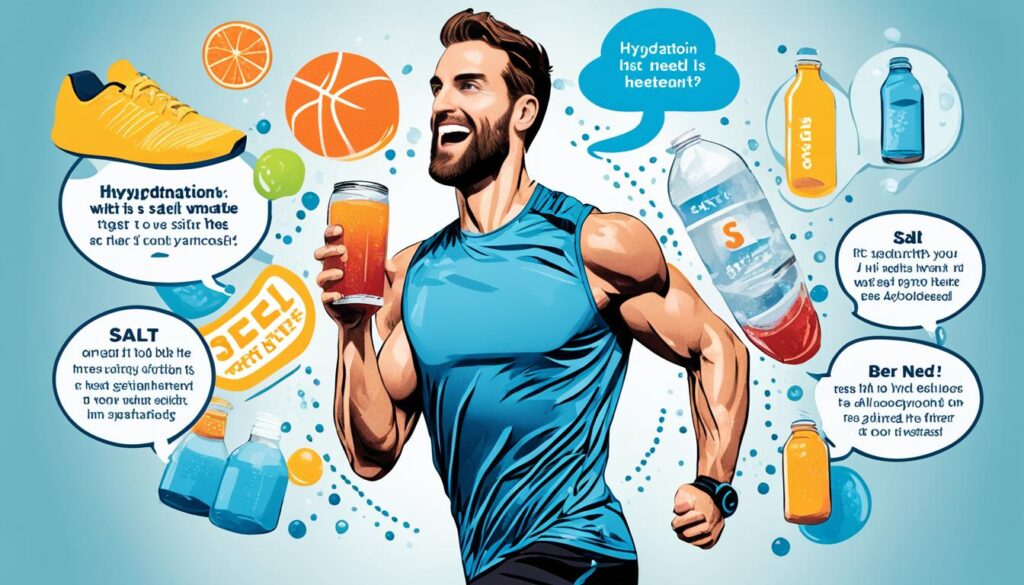
Debunking the “8 Glasses a Day” Rule
Many think people should drink 8 glasses of water every day. But, a study in 2002 found this isn’t clear advice12. How much water you need varies, based on your body size, what you do, and the weather13. A 2% loss of body water can hurt how well you move13.
Remember, you get about 20% of your fluids from food, not just drinks12,13. So, don’t follow the 8 glasses rule too strictly.
Thirst as a Reliable Indicator of Hydration Needs
Some say thirst isn’t always right about how much water you need. This is especially true for older people who don’t feel thirsty as often. But, it’s usually a good sign. Paying attention to thirst helps you stay hydrated.
Even if your urine is dark, it might not mean you’re dehydrated, a 2017 study says12. Urine color is helpful, but it’s not the only measure of hydration.
Knowing the truth about water needs helps. Remember, age, body size, and what you do matter. For example, kids need less water than adults. Men often need more water than women13.
Water is vital for staying healthy. We can live longer without food than without water13. So, learn the right info and drink enough to keep your body working well.
Electrolytes: Beyond Just Sodium
Sodium is talked about a lot when it comes to staying hydrated. But, it’s not the only important electrolyte. Others like potassium, magnesium, and calcium are key too. They help keep our fluids balanced and our bodies working well. When we don’t have enough electrolytes, we can feel tired, dizzy, and get muscle cramps14.
The Role of Potassium, Magnesium, and Calcium
Potassium is vital for our muscles and nerves. Losing it when we sweat can lead to cramps and feeling tired. Magnesium helps us make energy and move our muscles, which is crucial for people who exercise a lot. For adult women, it’s recommended to get at least 310mg a day. Adult men should aim for 420mg15.
Calcium is necessary for strong bones and muscles. Losing calcium through sweat can hurt our performance. Each of these minerals is important in its way.
Foods Rich in Electrolytes for Athletes
To make sure we have enough electrolytes, eating the right foods is key. Here are some top sources:
| Electrolyte | Food Sources |
|---|---|
| Potassium | Bananas, avocados, spinach, sweet potatoes, white beans |
| Magnesium | Spinach, nuts (almonds, cashews), seeds (pumpkin, chia), dark chocolate |
| Calcium | Dairy products (milk, yogurt, cheese), leafy greens (kale, collard greens), tofu |
| Sodium | Table salt, pickles, olives, soup broths, sports drinks |
Eating foods like bananas for potassium and spinach for magnesium can keep electrolytes in balance. Dairy products and salt help too15. For those who exercise hard, taking electrolyte supplements or using sports drinks is a good idea. But, not everyone needs these if they eat well and drink plenty of water15.
Knowing what your body needs for hydration is vital. It helps prevent dehydration, improve how you perform, and feel good overall15. A diet full of foods with electrolytes and being mindful of how much you drink ensures your body is ready for action.
Hydration and Athletic Performance
Staying hydrated is key for athletes to perform their best. It affects how long and how hard they can work out. Good hydration keeps the body working well, puts off tiredness, and helps reach top results.
The Impact of Dehydration on Endurance and Strength
Even a small loss of body weight from dehydration, just 2%, can make endurance exercise harder16. Not being hydrated well makes it tough for the body to control temperature and move blood to muscles. This could lower performance16. For each hour of exercise, athletes might lose up to 2 quarts of fluid. In endurance sports, like long-distance running, this could jump to 3 quarts17. Dehydration cuts muscle strength and power by 2-3%. It might slice high-intensity endurance efforts by about 10%16. A lack of body water can drop muscle strength by 5.5 ± 1.0% and anaerobic power by -5.8 ± 2.3%16. Losing 2.9% of your body weight in water can also lessen upper and lower body anaerobic power16.
Proper Hydration for Optimal Results
For top performance, athletes need a careful drinking plan. This plan should cover before, during, and after training or a game. A good start is 24 ounces of sports drink or water with added electrolytes before starting. During long activities, like an hour for adults, use sports drinks. After, pick either water or a drink made for rehydrating17. While active, athletes should sip 200 to 300 ml of fluid every 10 to 20 min16. How much to drink varies by age: Adults need between 6 to 12 ounces every 20 minutes, Teens 11 to 16 ounces, and Kids 3 to 8 ounces every 20 minutes17. Watching urine color is a good way to check your hydration. Light yellow means you’re drinking enough, but dark yellow or amber shows you need more water7.
Electrolytes are salts and minerals that your muscles and nerves need to work right17. Sports drinks with 6-8% sugar help replace lost energy. For salt, adults should aim for 200 milligrams in a 16-ounce drink. A 12-ounce drink should have at least 150 milligrams17. You can get back these lost electrolytes with tablets or foods like bananas, avocados, and yogurt7.
Knowing what good hydration means and avoiding dehydration helps athletes do better and stay healthy. Designing a drinking plan just for you is smart. Consider where you are, what you’re doing, and how much you sweat to keep your performance and health at their peak.
Creating a Personalized Hydration Plan
It’s crucial for athletes to drink the right amount of fluids. A good hydration plan considers body size, sweat rate, how much you exercise, and the weather. To make a plan that fits you, first find out how much you sweat. Weigh yourself before and after a workout10. Then, use this to decide how much to drink later. A rule of thumb is to drink an amount equal to half your weight in water. You should also check the color of your urine and how thirsty you feel to understand your body’s needs10.
Your plan should change based on how hard and long you work out. When exercising, try to drink 4 to 8 ounces of water every 15 to 20 minutes10. That’s about a few sips or gulps of water or a sports drink. After exercise, focus on topping up the fluids you lost. A good guide is to drink about 3 cups of water for each pound you shed during the workout10. Eating or drinking things with electrolytes is also smart because they help keep liquids in your body. The advice is to have 500 to 1000mg of sodium for each hour you work out18.
Over time, you should check and tweak your hydration plan as your schedule, surroundings, or needs change. There are tools like the Water.io hydration calculator that can help. They consider things like your age, weight, how active you are, your objectives, and the weather19. By sticking to your plan and adjusting it when necessary, you make sure your body stays well-watered. This is key to making sure you perform at the top of your game.
FAQ
Why is hydration important during exercise?
What are the signs and symptoms of dehydration during exercise?
How much fluid should I drink before exercising?
What should I drink during exercise to stay hydrated?
How can I determine my daily water needs?
Do hydration needs vary depending on the type of exercise?
How do environmental factors affect hydration during exercise?
Are there any common myths or misconceptions about hydration?
What role do electrolytes play in hydration during exercise?
How can I create a personalized hydration plan?
Source Links
- https://www.onepeloton.com/blog/best-way-to-hydrate/
- https://educatefitness.co.uk/workout-hydration-the-ultimate-guide-to-staying-hydrated-for-optimal-performance/
- https://www.ground-based.com/blogs/daily-health/hydration-and-exercise
- https://familydoctor.org/athletes-the-importance-of-good-hydration/
- https://my.clevelandclinic.org/health/diseases/9013-dehydration
- https://educatefitness.co.uk/hydration-practices-before-and-after-exercise-the-ultimate-guide-to-optimal-performance/
- https://www.fitbudd.com/post/quenching-the-thirst-for-fitness-the-ultimate-guide-to-staying-hydrated-during-workouts
- https://www.nata.org/sites/default/files/hydration-guidelines_handout.pdf
- https://www.bjc.org/news/how-much-water-do-i-need-guide-staying-hydrated
- https://www.massgeneralbrigham.org/en/about/newsroom/articles/tips-for-staying-hydrated
- https://www.leafhome.com/hydration-hacks-for-the-active-season-maximizing-performance-with-hydrated-exercise/
- https://www.npr.org/2022/09/21/1124371309/busting-common-hydration-water-myths
- https://fieldsportstraining.com/blogs/news/essential-hydration-facts-and-water-intake
- https://compedgept.com/blog/hydration-and-working-out-athletes-guide-to-water-electrolytes-performance/
- https://strongeru.com/ultimate-guide-to-summer-hydration-and-electrolytes/
- https://www.ncbi.nlm.nih.gov/pmc/articles/PMC8336541/
- https://www.hopkinsmedicine.org/health/wellness-and-prevention/nutrition-and-fitness/sports-and-hydration-for-athletes
- http://nutritionforrunning.com/the-ultimate-guide-hydration-for-runners/
- https://us.water.io/blogs/hydration/the-ultimate-guide-to-optimizing-your-running-performance-with-proper-hydration
